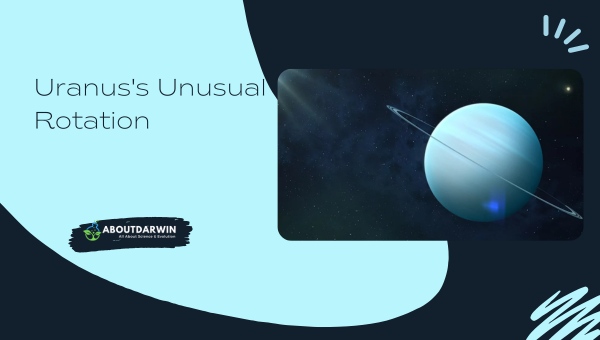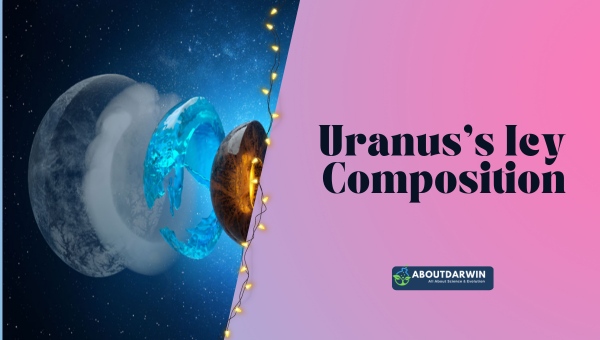Physical Address
304 North Cardinal St.
Dorchester Center, MA 02124
Uranus, the seventh planet from the Sun, is a fascinating world shrouded in mystery and unique characteristics. Unlike other planets in our solar system, it rotates on its side, resulting in extreme seasonal variations.
With its striking blue hue caused by methane in its atmosphere, Uranus boasts a collection of 27 known moons and a faint ring system.
This icy giant challenges our understanding of planetary formation and evolution, making it a captivating subject for astronomers and space enthusiasts alike. Prepare to be intrigued by the wonders that this distant planet has to offer!
Contents
Uranus, often referred to as the “ice giant,” holds a unique place in astronomical history. What is Uranus known for? Its discovery marked the first identification of a new planet since ancient times, revolutionizing our understanding of the Solar System.
William Herschel discovered Uranus on March 13, 1781, while observing the night sky with a 6.2-inch reflecting telescope he had built himself. Initially mistaken for a comet due to its unusual movement, Herschel’s careful observations confirmed it as a planet.

Interestingly, Uranus had been observed earlier by John Flamsteed in 1690, but he cataloged it as a star. Herschel originally suggested naming the planet Georgium Sidus in honor of King George III, but it was ultimately named Uranus, after the Greek god of the sky, to align with mythological naming conventions.
The discovery of Uranus expanded the known boundaries of our Solar System, showcasing the potential of modern astronomy and inspiring further exploration of the cosmos.
This pivotal moment demonstrated humanity’s ability to push beyond familiar horizons and revealed the vast complexity of our celestial neighborhood.
Uranus, the seventh planet from the Sun, is known for its intriguing and unique features that set it apart from other planets in our Solar System.
Its unique characteristics, such as its composition and atmospheric phenomena, make it a compelling subject of study.
Here are ten interesting facts that highlight the unique things about Uranus.
These Uranus interesting facts illustrate that this ice giant is not merely another distant planet; it possesses remarkable features that continue to intrigue astronomers and planetary scientists alike.
Uranus rotates on an axis that is tilted at an extraordinary angle of approximately 98 degrees from the vertical, making it the only planet that spins nearly on its side. In contrast, Earth’s axial tilt is about 23.5 degrees.

This extreme tilt likely resulted from a significant collision with a planet-sized body during the early formation of the solar system, which occurred billions of years ago. The orientation of Uranus’s axis has profound implications for its climate and seasonal changes.
Due to its unusual tilt, Uranus experiences the most extreme seasonal variations of any planet in the solar system. Each pole is subjected to approximately 42 years of continuous sunlight followed by 42 years of darkness.
The following table summarizes this phenomenon:
| Location on Uranus | Duration of Daylight | Duration of Darkness |
|---|---|---|
| North Pole | 42 years | 42 years |
| South Pole | 42 years | 42 years |
Despite this dramatic variation in sunlight, Uranus maintains a relatively stable climate. Its distance from the Sun means it receives minimal solar energy, resulting in uniformly cold temperatures averaging around -357°F (-216°C), making it one of the coldest planets in the solar system.
Uranus completes a full rotation in just over 17 hours, specifically 17 hours and 14 minutes. This rapid rotation contributes to a quick cycle of day and night across its surface, which can be summarized as follows:
| Characteristic | Duration |
|---|---|
| Full Rotation | 17 hours 14 minutes |
The atmosphere of Uranus is characterized by strong zonal winds that can reach speeds of up to 560 miles per hour (900 kilometers per hour) at the equator. However, these winds decrease significantly at higher latitudes.
The planet’s unique tilt also affects its atmospheric dynamics, leading to intriguing weather patterns. Uranus’s extreme axial tilt results in unusual rotational characteristics, significant seasonal variations, and complex atmospheric phenomena.
Ongoing research continues to explore the origins of this tilt and its effects on the planet’s environment.
Uranus, known as the “ice giant,” features a unique composition dominated by icy materials. Beneath its upper atmosphere of hydrogen and helium lies a substantial ice mantle primarily made of water, ammonia, and methane.

This distinctive structure differentiates Uranus from gas giants like Jupiter and Saturn.
Uranus’s striking blue color results from methane in its atmosphere, which absorbs red light and reflects blue light. This phenomenon gives the planet its vivid appearance.
Structure Breakdown:
| Layer | Composition |
|---|---|
| Upper Atmosphere | Mostly hydrogen and helium with traces of methane |
| Ice Mantle | A thick mixture of water, ammonia, and methane |
| Core | Silicate rock, likely surrounded by an ice-rich shell |
Scientists speculate that the ice mantle may contain superionic ice, which could influence Uranus’s magnetic field.
Unlike other planets, Uranus has a tilted magnetic field that does not align with its rotational axis, leading to an unusual magnetosphere characterized by asymmetry and auroral bursts.
Uranus is also notable for its extreme climate, holding the record for the lowest temperature in our solar system at -371°F (-224°C). This icy composition contributes to its frigid environment.
Uranus, the seventh planet from the Sun, is renowned for its extreme cold, with an average surface temperature of approximately -357°F (-216°C). This frigid environment is primarily due to its significant distance from the Sun, coupled with a lack of internal heat sources.
Factors Contributing to Cold Temperatures:
Distance from the Sun: Uranus is over 1.7 billion miles (2.8 billion kilometers) away, receiving only 0.25% of the sunlight that Earth does. For context:
Lack of Internal Heat: Unlike other gas giants such as Jupiter and Saturn, which emit substantial heat from their cores, Uranus has a relatively cool core and radiates minimal internal heat into space.
Axial Tilt: Uranus has an extreme axial tilt of 98 degrees, causing its poles to alternate between prolonged sunlight and darkness during its 84-year orbit around the Sun. Each pole experiences about 42 years of continuous sunlight followed by 42 years of darkness.
Uranus’s atmosphere consists of several layers, each with distinct temperature ranges:
Uranus’s extreme cold is a result of its distance from the Sun, lack of internal heating, and significant axial tilt, leading to unique seasonal variations not found on other planets in our solar system.
Uranus is remarkable for its extreme axial tilt of approximately 98 degrees, making it the only planet in our solar system that rotates nearly on its side. This tilt leads to unusual seasonal patterns and weather phenomena.
Axial Tilt Comparison
| Planet | Axial Tilt (Degrees) |
|---|---|
| Mercury | 0.03 |
| Venus | 177.36 |
| Earth | 23.44 |
| Mars | 25.19 |
| Jupiter | 3.13 |
| Saturn | 26.73 |
| Uranus | 97.77 |
| Neptune | 28.32 |
The consequences of this tilt are profound:
The origin of Uranus’s unusual tilt is still debated, but the leading theory suggests it resulted from a massive impact with a celestial body early in its formation.
Some researchers propose that a lost moon may have contributed to this tilt by exerting gravitational forces over millions of years before colliding with the planet.
Uranus’s extreme axial tilt not only makes it a subject of scientific interest but also highlights the diversity and complexity of planetary systems in our solar system.
Uranus’s ring system is often fascinating, as it shares some striking similarities to Saturn’s famous rings. Both planets have complex sets of rings composed primarily of ice and dust particles orbiting around them.
Uranus has 13 known rings, which are relatively narrow and darker in color compared to Saturn’s bright and wide rings. The rings of Uranus were discovered in 1977, and they’ve been intriguing astronomers ever since. Here’s a breakdown of the main rings:
| Ring Name | Radius (km) | Width (km) |
|---|---|---|
| Zeta | 38,000 | 2-6 |
| 6 | 41,837 | 2-5 |
| 5 | 42,235 | 1-3 |
| 4 | 42,571 | 3-5 |
| Alpha | 44,718 | 5-10 |
| Beta | 45,661 | 5-10 |
| Eta | 47,175 | 3-4 |
| Gamma | 47,627 | 4-6 |
| Delta | 48,290 | 4-6 |
| Lambda | 50,026 | 4-6 |
| Epsilon | 51,146 | 20-30 |
| Nu | 62,000 | 2-3 |
| Mu | 92,000 | 3-4 |
Like Saturn, Uranus’s rings mainly comprise ice particles with a smaller amount of rocky material. However, the ice in Uranus’s rings is darker and more contaminated, possibly due to the presence of organic compounds.
One significant difference between the two planetary ring systems is the orientation of their rings. Saturn’s rings are aligned with its equator, while Uranus’s rings are uniquely oriented vertically, matching the planet’s extreme tilt of 97.8 degrees.
Another point of interest is how both planets have shepherd moons. These small moons help maintain the stability and shape of the rings by gravitationally interacting with the ring particles.
Some of the known shepherd moons of Uranus include:
Despite these similarities, there’s still much to learn about Uranus’s ring system and how it compares to Saturn’s. Uranus’s rings’ impressive structure and composition continue to captivate me and many others in the scientific community.
Uranus stands out as a captivating planet within our solar system, characterized by its striking blue-green color and unusual axial tilt. This tilt causes extreme seasonal changes, making it unlike any other planet.
With a complex ring system and 27 known moons, Uranus offers a wealth of interesting facts that intrigue astronomers and space enthusiasts alike.
Its unique features not only enhance our understanding of planetary science but also inspire continued exploration of the mysteries that lie beyond Earth.